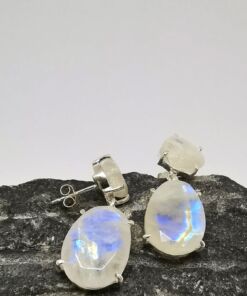Handmade Pink Quartz Earrings BD0166
Handmade earrings with multifaceted chalcedony with pink quartz set in sterling silver.
Dimensions: 30 mm x 10 mm.
It comes with a certificate of authenticity.
The photo may not represent 100% of the product features.
45,00 €
In stock
Chalcedony is a cryptocrystalline form of silica, which is composed of very fine intergrowths of quartz and moganite. Both are silica minerals. Chalcedony has a waxy luster and can be translucent. It can assume a wide range of colors, but those most commonly observed are white to gray, blue or a shade of brown ranging from pale to nearly black. Its name comes from Latin and is probably derived from the town of Chalcedon in Turkey. Another reference to a gem by the name of khalkedon (χαλκηδών) is found in the Book of Revelation (21:19).
Quartz & rose quartz are the most common minerals, making up almost 12% of the Earth’s crust It is also known as silicon dioxide and is encountered in sedimentary and volcanic rocks. When found at high temperature during the last phase of its precipitation, quartz crystallizes within only a few months. It is mined in Brazil, Japan, America and Switzerland.
| Material | 925 Silver, Precious/Semi-Precious Stones |
|---|---|
| Earrings | Drop Earrings |









